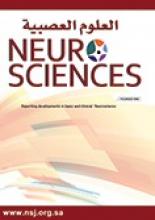Abstract
OBJECTIVE: The determination of serum magnesium levels in migraine.
METHODS: In a case control study performed between January 2007 and December 2007 at Tabriz University of Medical Sciences, Tabriz, Iran, 140 migraine patients were enrolled and their level of serum magnesium was determined and the results were compared with 140 healthy people who did not have any headache, kidney, or gastrointestinal disorders, and no consumption of magnesium complements.
RESULTS: Migraine patients (22 male, 118 female) with a mean age of 33.82+/-10.31 and 140 healthy people (26 male, 114 female) with a mean age of (34.19+/-9.95) were enrolled. Forty patients had aura and 100 patients did not have aura. The average serum magnesium level in the patient group (26.14+/-4.3) was significantly lower than the control (31.09+/-4.32) group (p=0.000). There was no significant difference between the mean level of serum magnesium in patients with migraine with aura and without aura, however, there was a significant linear relationship between the amount of serum magnesium and the frequency of headache.
CONCLUSION: Serum magnesium in migraine patients was significantly lower than the normal population and related to the frequency of migraine attacks, supporting the use of magnesium in prevention and treatment of migraine.
- Copyright: © Neurosciences
Neurosciences is an Open Access journal and articles published are distributed under the terms of the Creative Commons Attribution-NonCommercial License (CC BY-NC). Readers may copy, distribute, and display the work for non-commercial purposes with the proper citation of the original work.






